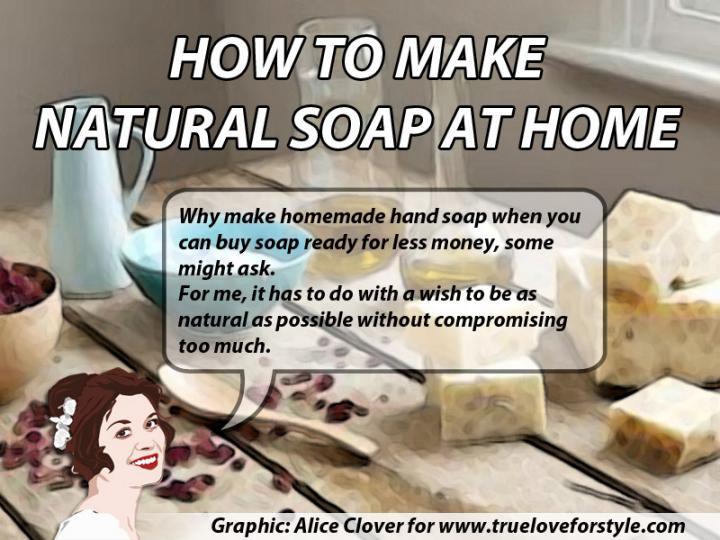FEATURED

-
3.9K Views 0 Comments 1 Like

Why make homemade hand soap when you can buy soap ready for less money, some might ask. And it is a good question. There are lots of different answers to this question as people will have different reasons for getting started on making soap at home. For me, it has to do with a wish to be as natural as possible without compromising too much. I have a desire to use clean, natural products at home where I don’t have to worry about chemicals, parabens, and all kinds of toxic ingredients that are most often found in beauty products. I want to go as natural as possible but I still want my everyday luxury in terms of beauty products that contribute to my well being.
For a long time, I was getting skin that was more and more irritated. The skin on my hands was dry and brittle and tons of hand cream didn’t solve the problem. I tried many different remedies and I changed soaps several times. When I finally found a hand soap that was gentle to my hands it would cost more than I found suitable for hand soap. At this point of my life I was realizing the impact of all the unnatural ingredients that are in our everyday products and it became increasingly important for me to identify these problems and get rid of them.
Commercially made hand soap often contains many ingredients that not belong in soap. If you examine the list of ingredients you probably won’t be able to pronounce most of them. If that is the case it is a good idea to stay away from them. Commercial soaps contain ingredients that make them attractive and long lasting. Soap making is about alchemy; about mixing few ingredients together until it takes another form. There are surfactants, detergents and emulsifiers that make sure that the soap has a lovely texture, the right amount of foam and that it is mixed well. Often there are preservatives to prevent the soap from getting harsh and there are perfumes to make sure that the soaps are nicely scented. Most of these ingredients are superfluous. Soap is so much better when the contents are pure and natural. That makes soap that is healthier for your skin and for the environment as well. In today’s world that is something that is really worth appreciating.
Being fascinated by the process of making soap at home I decided to get started. First, it requires a thorough research of the subject.Then it requires a bit of equipment, but not much. You can get far with few basic tools and some empty milk cartons to start with and you can leave the more advanced stuff for later. In the beginning you’ll need a lot of practice to get the techniques right so you’ll probably do a lot of experimenting at first. And that is what I love about soap-making; it allows you to keep experimenting. You can get really good at making soap at home but you can always get better, you can always evolve, you can experiment with new ingredients and you will never run out of new opportunities.
Having direct access to a lot of oil due to family in warm climates, I have a lot of pure olive oil that I can use as the main ingredients in my soaps. This gave me a great advantage as I never had to invest in expensive oils and that made it fairly cheap for me to get started on making my own homemade hand soap. Today, I use different kinds of oil in my soaps but olive oil is what I prefer even though I often combine it with other oils as well. If you don’t want to buy olive oil you can replace it with sunflower oil which is cheaper. Coconut oil, palm oil and safflower oil is often used as basic types of fat as well.
When looking for a fine natural handmade soap to make, a CLOVER SISTERS recipe using coconut and olive oil is a splendid variety. Both ingredients are good for your skin. To make it, you’ll need the following ingredients:
Please note, the water measurement is liquid, all others are weight. Step one, put on gloves and goggles, and then pour the lye into the water and stir well. This is a safety step – always pour the lye into the water, never vice versa. As lye reacts strongly (to put it mildly) to water, it may spatter, and this can be dangerous. By pouring the lye into the water, you can better control this. After mixing, set this aside to cool.
Next, combine the olive and coconut oils with the tallow, and gradually heat the mixture. Once all of it has melted and blended, take the pot off of the heat and allow it to cool like the lye mixture. In both cases, you don’t want them to get cold; keep the temperature just above 100° F, but not above 125° F.
Blend the lye solution with the melted oils. As with before, take care not to splash the mixture about. Keep stirring everything until the concoction traces, which means you see the mix looking a bit like cooked custard. If you don’t see this within the first fifteen minutes of mixing, which does happen often, stir it for fifteen minutes, and then stop for fifteen minutes. After that, stir it for five minutes separated by fifteen minute intervals. Once you see tracing, you’re ready to pour the raw soap into the prepared molds. If you have plastic, stainless steel or glass molds, just pour the soap in. with wooden or cardboard molds, you have to line them with wax paper to prevent the soap from sticking.
Set the molds aside for one to two days to cool. After that, pop the bars out. Very often, the soap will still be very soft. It just needs to cure for a while longer. Typically, one to three weeks will get the bars firm enough to use. If you’ve used a large block shape as a mold, you can cut the loaf into individual bars, and then put them aside to harden.
Happy soap making!


